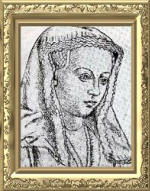|
Born
in Dijon, he was the son of
John the Fearless and Margaret of
Bavaria-Straubing. On 28 January 1405 he was named Count
of Charolais in
appanage
of his father and probably on the same day he was engaged to Michele of
Valois
(1395–1422), daughter of Charles VI of
France and Isabeau
of Bavaria. They were married in June of 1409.
Philip married Bonne of Artois (1393–1425), daughter of Philip of Artois, Count of Eu, and also the
widow of his uncle, Philip II, Count of Nevers, in Moulins-les-Engelbert
on November 30, 1424.
His
third marriage, in Bruges in 1430 with Isabelle of Portugal, daughter of John I of Portugal and Philippa of
Lancaster, produced three sons:
-
Antoine 1430, Brussels
– 1432 Brussels), Count of Charolais
-
Joseph
1432
– 1432 Count of Charolais
-
Charles 1433–1477), Count of Charolais and Philip's
successor as Duke, called "Charles the Bold" or "Charles the Rash"
Philip also had some eighteen illegitimate children,
including Antoine, bastard of Burgundy, by twenty four documented mistresses.
|
 |
 |
 |
|
Michelle
Duke Philippes
first wife |
Bonne d'Artois
Duke Philippe's
second wife |
Isabelle of Portugual
Duke Philippe
third wife |
|
 |
 |
|
Charles
le Téméraire
son
of Duke Philippe |
Marie
of Burgundy
grandchild
of
Duke Philippe |
Philip became duke of Burgundy, count of
Flanders, Artois and Franche Comté when his father
was
assassinated in 1419. Philip
accused Charles the Dauphin
of France and Philip's brother-in-law of planning the murder of his father which had taken place during a
meeting between the two at Montereau
and so he continued to prosecute the civil war
between the Burgundians
and
Armagnacs.
In 1420 Philip allied himself with Henry V of
England under the Treaty of
Troyes. In
1423 the alliance was strengthened by the marriage of his sister
Anne to John, Duke of Bedford, regent for Henry VI of England.
In
1430 Philip's troops captured Joan of Arc at Compiègne and
later handed her over to the English who orchestrated a heresy trial
against her, conducted by pro-Burgundian clerics.
Despite this action against Joan of Arc, Philip's alliance with
England was broken in 1435 when
Philip signed the Treaty of Arras (which completely revoked the
Treaty of Troyes) and thus
recognised Charles VII as king of France. Philip signed for a
variety of reasons, one of which may
have been a desire to be recognised as the Premier Duke in France.
Philip then attacked Calais, but this alliance with Charles was broken in 1439, with Philip
supporting the revolt of the French
nobles the following year
(an event known as the Praquerie) and sheltering the Dauphin Louis.
|
 |
 |
 |
 |
|
Duke Philippe
and his son |
Tapestry coat
of Arms |
Duke of Burgundy |
Order of the
Golden Fleece |
Philip's court can only be
described as extravagant. Despite the flourishing bourgeois culture
of Burgundy,which the court kept in close touch with, he and the aristocrats
who formed most of his inner circle retained
a world-view dominated by knightly chivalry. In 1430 he created his
own Order of the Golden Fleece, based
on the Knights of
the Round Table. He had no
fixed capital and moved the court between various palaces, the main
urban ones being Brussels, Bruges, or
Lille. He held grand feasts and other festivities, and the
knights of his Order frequently travelled throughout his territory
participating in tournaments. In a period from 1444-6
he is estimated to have spent a sum equivalent to 2% of Burgundy's
main tax income over the period, the recette génerale, with a single Italian supplier of silk and
cloth of gold, Giovanni di Arrigo
Arnolfini.
His court was regarded as
the most splendid in Europe, and became the accepted leader of taste
and fashion, which probably helped the Burgundian economy
considerably, as Burgundian (usually Netherlandish) luxury products
became sought by the elites of other parts of Europe. During his
reign, for example, the richest
English commissioners of illuminated manuscripts moved away from
English and Parisian products to those of the Netherlands, as did other foreign buyers. Philip himself is
estimated to have added six hundred manuscripts to the ducal
collection, making him by a considerable margin the most important
patron of the period.
|
 |
 |
 |
|
Court scene |
Court of
Philippe le Bon |
The Painter
Jan Van Eyck |
Philip was also a
considerable patron of other arts, commissioning many tapestries (which
he tended to
prefer over paintings), pieces from goldsmiths, jewellery, and other
works of art. It was during his reign
that the Burgundian chapel became the musical center of Europe, with
the activity of the Burgundian School of composers and singers. Gilles Binchois, Robert Morton, and later
Guillaume Dufay, the most famous composer of the 15th century, were
all part of Philip's court chapel.
Philip of Burgundy died 15 June 1467

return
wikipedia and various sources of
the Internet 2009
©
2008
- 2023 linda compagnoni walther
non profit site
all rights reserved
design by Evelyne Diggelmann-Walther
|
